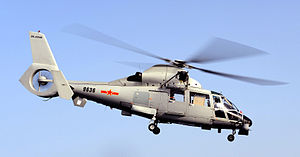Harbin Z-9
| Harbin Z-9 | |
|---|---|
 |
|
| A Chinese naval Z-9 departs HMS Cornwall | |
| Role | Medium multi-purpose utility helicopter |
| Manufacturer | Harbin Aircraft Manufacturing Corporation |
| First flight | 1981 |
| Introduction | 1994 |
| Status | Operational In production |
| Primary users |
China Pakistan |
| Produced | 1981-present |
| Number built | 200+ |
| Developed from | Eurocopter AS365 Dauphin |
| Variants | Harbin Z-19 |
The Harbin Z-9 (NATO reporting name "Haitun", Chinese: 海豚 for Dolphin) is a Chinese military utility helicopter. It is a licensed variant of the French Eurocopter AS365 Dauphin, and is manufactured by Harbin Aircraft Manufacturing Corporation.
The first Z-9 flew in 1981, and was built in China from components supplied by Aérospatiale as part of a production patent bought on 15 October 1980. On 16 January 1992, the indigenous variant Z-9B, constructed with 70% Chinese-made parts, flew successfully. The flight test was completed in November 1992 and the design was finalized a month later. Z-9B production began in 1993 and entered PLA service in 1994.
The Z-9B features 11-blade Fenestron faired-in tail rotor with wider-chord, all-composite blades replacing the 13-blade in AS 365N. As a light tactical troop transport, the Z-9 has the capacity to transport 10 fully armed soldiers. Generally the Z-9 is identical to the AS 365N Dauphin, though later variants of the Z-9 incorporate more composite materials to increase structural strength and lower radar signature. The helicopter has a four-blade main rotor, with two turboshaft engines mounted side by side on top of the cabin with engine layout identical to the AS 365N. The Z-9 teardrop-shaped body features a tapered boom to the tail fin, with rounded nose and stepped-up cockpit, and retractable gear and all flat bottom.
In 2002, Harbin obtained Chinese certification for the new H410A variant of the Z-9, which featured more powerful Turbomeca Arriel 2C turboshaft engines; Eurocopter issued official objections to Harbin's decision to continue production in spite of the license-production agreement having expired, leading to a period of highly sensitive international negotiations to resolve the dispute.
...
Wikipedia
